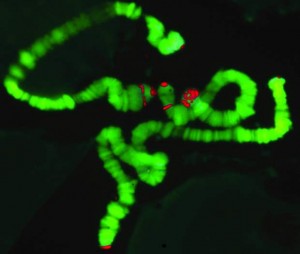
Eduardo Gorab/USPPink stains: triple helices produced in Rhynchosciara chromosomesEduardo Gorab/USP
The genetic material of all living beings, according to literature on the subject, is comprised of two spirals wrapped around each other. This is the famous DNA (deoxyribonucleic acid) double helix, the configuration of which was presented to the public in 1953 by the physicist Francis Crick and the biologist James Watson. The discovery yielded a Nobel Prize for the two scientists in 1962 and became crystalized as the official portrait of DNA. What is rarely mentioned is that before the Watson and Crick model, the chemist Linus Pauling had also attempted to describe how the molecules or nitrogenous bases that form genetic material (adenine, thymine , cytosine and guanine , better known as A, T, C and G) fit together. The triple helix he proposed turned out to be unsustainable, but under certain highly specific circumstances, DNA chains do, indeed, seem to bunch together in threes. Among the researchers who are investingating this unorthodox configuration are the geneticists Eduardo Gorab and José Mariano Amabis, from the Biosciences Institute of the University of São Paulo (IB-USP).
Gorab and Amabis showed that three ribbons of nitrogenous bases can spiral together in certain areas of the genetic material of the Rhynchosciara americana and Drosophila melanogaster flies. This unusual arrangement seems to be concentrated in the heterochromatin, a region of the chromosomes where the triple structure may help to compact the genetic material and where there is almost no genic activity, corroborating the notion that the triple structure works almost as a switch that turns the genes off. The Brazilian study began some 20 years ago, but was only published in 2009, in Chromosome Research.
New view
One of the people who continued researching the possibility was the biochemist Bernard Stollar, from Tufts Univeristy, in Boston, USA. “He inaugurated a new phase in the study of nucleic acides [DNA and RNA],” states Gorab. Stollar developed antibodies that bind to some triple helix compositions, a system that operates like a lock in which a key fits perfectly, as he explained in 1974 in Nature. However, he molded the lock with a specific key in mind: a DNA chain interwoven with two RNA chains, all in a single ribbon.
Mariano Amabis investigated in greater depth this molecular tool during the sabbatical year he spent at Stollar’s lab in the late 1980’s. There he discovered that the antibody designed by the US scientist also recognized triple helices made only out of DNA. This opened the door to new investigations. The work spent two decades hidden in the carefully crafted notebooks of Amabis, now retired from USP, but it reappeared in informal conversations around cups of coffee or end-of-day snacks. Gorab finally managed to recover the notebooks and to repeat the experiments in his São Paulo laboratory, confirming and expanding the results. “It wasn’t finding a triple helix that was a novelty, but adding a new tool to study this structure – Stollar’s antibodies,” he tells us.
In the genome of the drosophilae, the technique yielded different results from those of othe Canadian group led by Jeremy Lee at the University of Saskatchewan, using a different antibody. Gorab also added to the arsenal the fly Rhynchosciara – a key personage from the early days of Brazilian genetics, because it was in this fly that the geneticist Crodowaldo Pavan found certain segments in which the DNA multiplied itself in an unexpected manner (see Pesquisa Fapesp nº 168). The genome of this fly also has regions that are enriched with long strings of AAAAA and of TTTTT. Gorab took advantage of this particularity, because in laboratory work repetitive sequences of RNA (UUUUU) tend to couple with repetitive double helices, as illustrated by the red ribbon in the picture. Therefore, Gorabl thinks it is possible that the DNA from these repetitive regions in the Rhynchosciara fly may double over and that the naturally double structure may become altered, forming a triple helix that leaves out one of the DNA chains (as in the illustration at the beginning of this article).
Reality
“We must now find out under what circumstances this triple structure is formed, and whether it exists in the living fly or is the result of laboratory handling,” cautions Gorab. It is something to be checked, but other groups have already indicated that the triple helices not only exist in living animals, but also have an important regulatory function. One of these groups is that of the US scientist Thomas Cech, from the University of Colorado and Nobel Prize Chemistry laureate in 1989. In 2008, he published an article in Nature Structural & Molecular Biology suggesting that the triple helix of RNA might have a function in the action of telomerase, the enzyme responsible for the regeneration of the DNA of the telomeres, which form the extremities of chromosomes.
Henceforth, the geneticist from USP does not intend to leave the triple helices forgotten in the bottom of some test tube. The next steps include using the well-known genome of the drosophilae to discover the sequences that foster the formation of triple helices. These may also come to aid genic therapies, as one might eventually be able to synthetize single ribbons to complement the genes to be deactivated and then insert them, forming triple regions.
The project
Molecular aspects of heterochromatin in species from the family Sciaridae (Diptera: Nematocera) (nº 2008/50653-2); Modality Regular Research Awards; Coordinator Eduardo Gorab – IB/USP; Investment R$ 165,485.11
Scientific article
Gorab, E. et al. Potential sites of triple-helical nucleic acid formation in chromosomes of Rhynchosciara (Diptera: Sciaridae) and Drosophila melanogaster. Chromosome Research. v. 17. p. 821-32. August 2009.